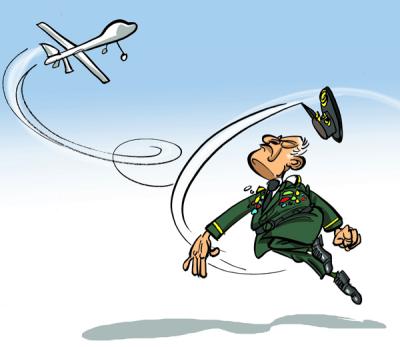Drones. You hear about them spying from everywhere though you can never see them. At last, however, you may now luckily read quite a lot about them in the written press. On February 6th, The New York Times revealed that air-strikes conducted in Yemen came from unmanned armed vehicles (UAVs) from an American military base in Saudi Arabia. Since, every hawk and every dove of every state in America made sure to have their screeching and cooing heard on the issue, drowning the debate in their deafening staccato. Why so much agitation, you may ask?
The role of UAV’s in U.S defence strategy has been steadily growing and could soon become its most important component. Under President Obama, the use of drones has already increased more than twofold than under his predecessor Monsieur Bush. Their numbers have increased from fifty-four in October 2001 to more than 4000 today. America intends to invest a further $17.9 billion on them over the next ten years.
It is not only their numbers that have increased, but also their loci of influence. Aside from the most frequent drone strikes you hear coming from North Waziristan and Yemen, UAVs have also been caught spying on Iran and late on Saturday, it was announced that 100 American soldiers would be deployed to set up a drone base in Niger. It seems U.S security strategists are obediently abiding by Napoleon’s old adage that ‘war is above all a business of positions’.
Yet, the clearest indication of this administration’s love of remote-controlled flying machines came with the appointment of John Brennan as the new CIA chief. Brennan had until now been in charge of the secret kill-list of Al-Qaeda insurgents under the Obama administration- he wrote down the names, the drones killed. The obdurate intensification of the program shows that the president finds something deeply enticing with the UAVs.
Think about it: drones enable you to peer down onto the enemy’s base without anyone being inside the machines. They also come much cheaper and require less coordination than a ground infantry operation. Today, the United States is able to assist France in their Malian operation through drones deployed from Niger- not one American life will be at risk. Yet, their greatest advantage, we are told, is that they can take down an enemy with minute precision with zero collateral damage, that is, with no civilian casualty. Or can they?
Take the case of Salem Ahmed bin Ali Jaber, for instance, who was a cleric denouncing Al-Qaeda in his village mosque in eastern Yemen. He was killed as a drone missile shot down its target, an insurgent with whom Mr Jaber and other men were arguing under a cluster of palm trees. Over 3,500 people have been killed, just like them, in 420 drone strikes under Obama. I will concede that the case of Mr Jaber does not in itself question the accuracy of the UAVs, but questions instead the judgement of those who have decided to strike.
How do a group of men arguing under a cluster of trees in Yemen constitute a direct and imminent threat to U.S national security? The American hawks and doves were quite happy to avoid this inconvenient question until two Predator drones shot down Hellfire missiles on Anwar Al-Awlaqi’s vehicle in September 2011. Al-Awlaqi was a U.S citizen alleged to have helped the former UCL student Umar Abdulmutallab in his bomb attempt on Northwest Airlines Flight 253 in December 2009. The killing of a U.S citizen was thrown into the lions’ den of the American press and suddenly, killing clerics in faraway mountains was not quite OK anymore. And what of the emperor? Was it OK for him to execute his own subjects at will?
Only now is Congress waking up to the reality of the true extent of the drone program. It is still unsure how to respond to all this partly because just like us, it is treading into largely unknown territory. In the absence of any light coming from the White House, congressmen have timidly whispered for greater checks on the president’s prerogative in the form of a ‘drone court’, composed of judges, to decide whether to give a green light to the president’s shooting-down order. Neal Katyal of the New York Times thinks it is a bad idea. I think it is an absurd one.
But congress must conjure something to impose a check on the president’s prerogative. For unilateral action has never been well received among liberal democrats (remember Bush). Saskia Sassen of Columbia University, an authority, even goes so far as arguing on Al-Jazeera that the drones program signals a new era for liberal democracies, “where the executive branch gains power partly through its increasingly international activities.”
It is difficult to disagree. As the debate over the program rages in the press and in Congress, drone bases continue to be built far to the East and the silence from the White House remains religious. One can hardly eschew the conclusion that Mr Obama’s mantle of liberal Nobel Peace Prize winner hides a far more ruthless commander-in-chief.
The Mantle of Illusion
- Publicité -
EN CONTINU ↻
- Publicité -

